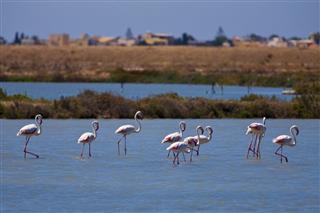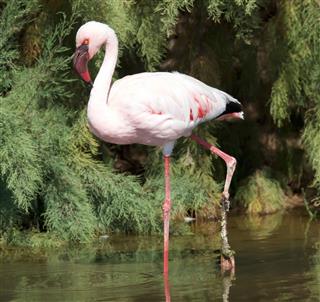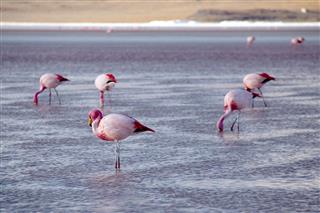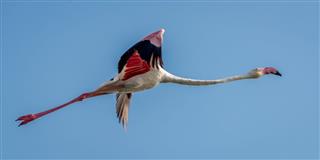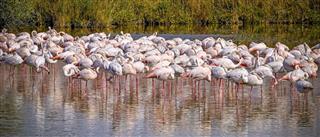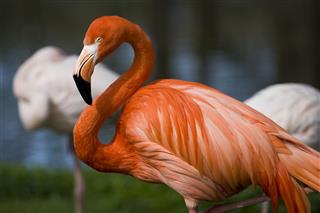
The flamingo is a large wading bird with shades of pink and scarlet plumage. There are many interesting facts about flamingos, including the fact that its eye is actually larger than its brain!
Did You Know?
The word flamingo comes from the Spanish word flamengo, an earlier form of flamenco. These words were derived from the Latin word flamma, which means ‘a flame’.
The habitat of these birds comprises large shallow lakes, lagoons, mangrove swamps, tidal flats, and sandy islands above the low tide mark. Adult flamingos range from 36 to 50 inches in height, with a wingspan of about 60 inches, and weigh around 8.75 lbs on an average.
However, these statistics differ for different species. The bird has such a distinctive appearance, that in any given locale it is likely to be the only tall, pink bird. They have long, sinuous necks, slender legs, and black-tipped bills that achieve a downward bend upon maturity. Let’s get down to learn some interesting facts about these beautiful creatures.
Facts You Should Know About Flamingos
Flamingos are found in warm, shallow and watery regions of many continents. Their vast habitats include estuaries and saline or alkaline lakes in Africa, Asia, North America, Central America, South America, and Europe. These highly adaptable birds can live in hot volcanic lakes, as well as in icy lakes of the Andean mountains.
A flamingo’s beautiful color comes from the algae, diatoms, and small crustaceans that they eat, which are rich in the carotene pigment.
Their interesting feeding technique involves stirring up the mud and water with their long legs and webbed feet. They then bury their bills, or even their entire heads upside down in the water, and suck up both mud and water. They shake their head from side to side to expel the excess mud and water, hold back and eat the plankton, tiny fish and fly larvae. When feeding, flamingos hold their breath.
They are commonly witnessed preening, which takes up a considerable amount of time everyday. They preen using their bills to spread oil from a gland near the base of their tail through their feathers.
Contrary to their appearance, these are surprisingly fluid swimmers. Their webbed toes help them swim and stand in soft mud. However, they don’t swim unless the water is too deep to waddle in.
They live in groups referred to as flocks or colonies. The large numbers provide safety against predators (flamingos have a few natural predators), especially while they feed with their heads underwater. They also don’t nest unless there are other flamingos around.
They live in groups referred to as flocks or colonies. The large numbers provide safety against predators (flamingos have a few natural predators), especially while they feed with their heads underwater. They also don’t nest unless there are other flamingos around.
Females lay only one egg per year and do not lay another one if, by any chance, the egg suffers damage.
Both parents regurgitate food which is fed to the baby, and both mother and father secrete a milk-like substance that provides their young with proper nourishment. This goes on till the baby’s beak is fully developed and is capable of hunting for its own food.
A flock of flamingos taking off is a truly magnificent sight. They gather speed by running prior to taking off and flap their wings almost constantly during flight. A flock can reach to a speed of 31 to 37 mph.
In recent times, changes in flamingo migration patterns have been witnessed due to environmental changes and global warming. These birds easily travel long distances and can cover over 300 miles at a stretch in a single night.
The lifespan of these birds is somewhere between 20 – 30 years in the wild, though these may live up to 50 years in captivity.
A total of six species of flamingos have been identified, namely, Greater Flamingo, Lesser Flamingo, James’s Flamingo, Andean Flamingo, Chilean Flamingo and Caribbean Flamingo.
Greater Flamingos are largest of all the species and can grow up to 5 feet tall, whereas Lesser Flamingos are the smallest attaining a height of about 3 feet.
Resting on one leg is a technique which these birds have adopted to minimize the loss of body heat to cold water of shallows.
In some areas, flamingo fat is considered to be a treatment option for tuberculosis.
The long and slender neck of a flamingo consists a total of 19 bones.
Keratin, a very tough substance, is the major structural material of the beak and feathers of flamingos.
Flamingos are often seen producing different vocalizations ranging from growling, honking and grunting.
The Andean Flamingo is categorized as vulnerable species by the International Union for the Conservation of Nature (IUCN), with figures showing only 30,000 of them alive in the wild.
The male and female share equal responsibility in parenting. Both of them pile up mud to build a nest in which the female lays one egg. After about 30 days of incubating, which is done in turns, the egg hatches to produce a chick with gray or white plumage.
Flamingos are defenseless creatures which do not fight back and simply fly away when they feel threatened.
These birds have a good eyesight and color perception, a good hearing ability, but have a poor sense of smell and taste.
As observed in the Philadelphia zoo, these birds display group activities with hundreds of birds participating together. Group displays like “wing salutes”, “head-flagging” and “marching” are a measure to regulate hormonal cycling for the mating season.
Lesser Flamingos found in East Africa form the largest flocks of birds with greater than one million of them flocking together.
The beauty of flamingos has never failed to grab human attention and that’s the reason why many people wish to keep them pets. However, since these birds are better left alone in the wild, one must refer to respective state laws to learn the legalities governing their ownership. You would also be surprised to know that on one hand, the Ancient Egyptians related a flamingo to the god Ra, whereas on the other hand, Ancient Romans enjoyed the bird’s tongue as a delicacy. Strange! Isn’t it?










